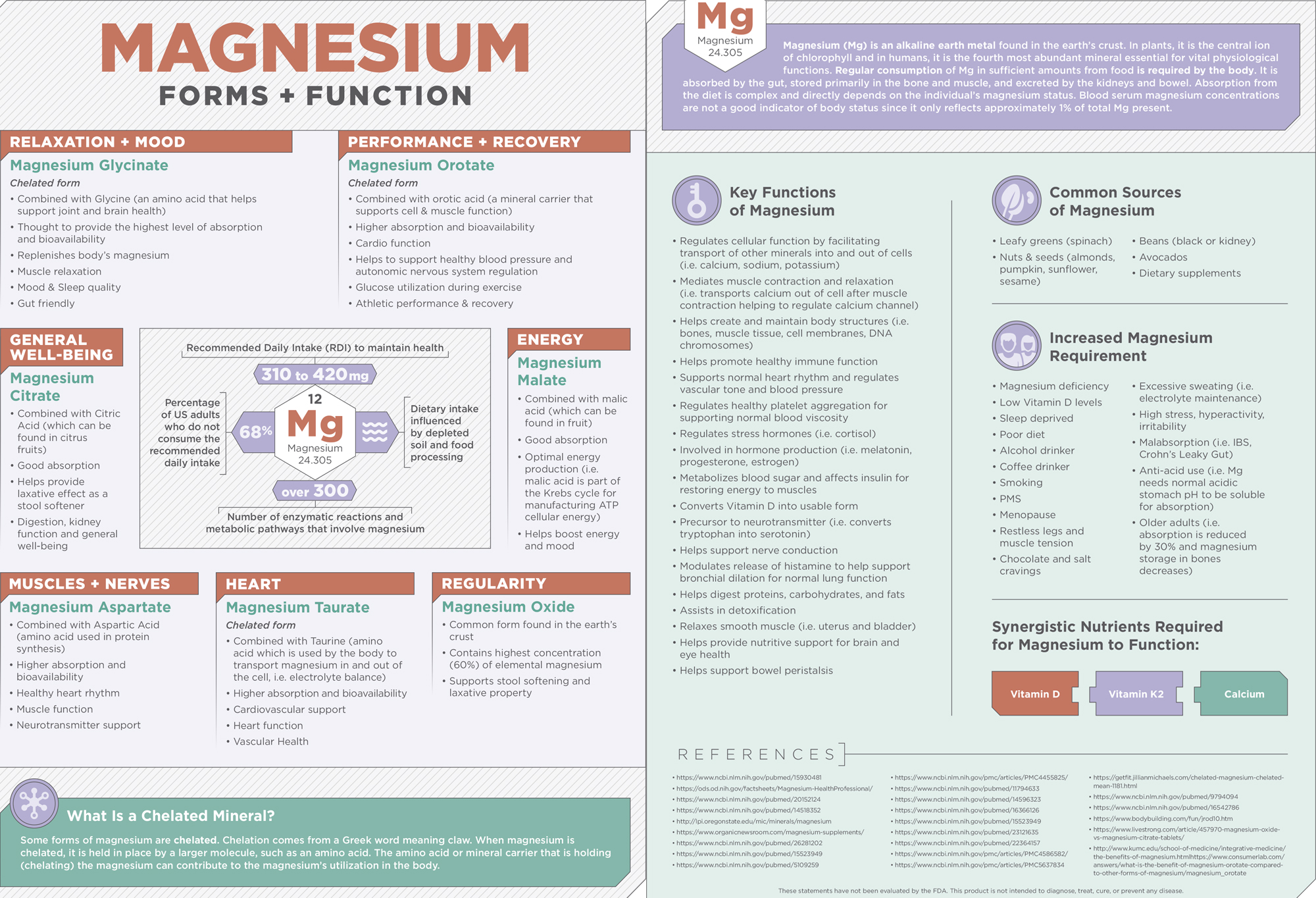Your body absorbs certain magnesium supplements more readily than others. Specific forms may also be better suited for particular health concerns.

Magnesium participates in over 300 vital metabolic processes, including energy generation, blood pressure control, nerve signaling, and muscle contraction.
Low magnesium status has been linked to a variety of health problems, such as type 2 diabetes, cardiovascular disease, osteoporosis, and migraines.
Although many whole foods — including green leafy vegetables, legumes, nuts, and seeds — provide magnesium, as many as two-thirds of people in Western countries don’t meet their magnesium needs from diet alone.
Keep reading to discover ten different forms of magnesium supplements and their common uses.
1. Magnesium citrate
Magnesium citrate is magnesium combined with citric acid.
This acid occurs naturally in citrus fruits and gives them their tangy, sour taste (3).
Magnesium citrate is one of the most widely available magnesium supplement types and is sold globally.
A small study of 14 men indicates this form is among the more bioavailable, meaning it’s absorbed in the gut more efficiently than some other varieties.
It’s commonly taken by mouth to correct low magnesium levels. Because it can act as a mild laxative, higher doses are sometimes used to treat constipation.
It’s also promoted occasionally as a calming supplement for symptoms of depression and anxiety, though more research is required to confirm these benefits.
SummaryMagnesium citrate is a commonly used, well-absorbed magnesium supplement. It’s mainly used to restore magnesium levels and to treat constipation.
2. Magnesium oxide
Magnesium oxide is a salt composed of magnesium and oxygen.
It forms a white, powdery material and is often available as a powder or in capsules (6).
This form is not typically the first choice for preventing or treating magnesium deficiency, as research indicates it may be poorly absorbed by the digestive system.
Instead, it’s more commonly used to relieve digestive discomfortes such as heartburn, indigestion, and constipation. Some people also use it for migraine prevention, though evidence that magnesium deficiency causes migraines remains limited.
SummaryMagnesium oxide can help ease digestive complaints like heartburn and constipation. Because it’s not well absorbed, it’s not ideal for raising magnesium levels. Talk with a clinician before using magnesium oxide.
3. Magnesium chloride
Magnesium chloride is a magnesium salt that contains chlorine — an element known for forming salts with metals like sodium and magnesium.
It’s well absorbed in the gut, making it a versatile supplement used to treat low magnesium status (, , 10).
People most often take magnesium chloride in capsule or tablet form, but it’s also an ingredient in topical products such as lotions and ointments.
Although topical preparations are marketed to relax sore muscles, there’s limited scientific proof that these products significantly raise magnesium levels (11).
SummaryMagnesium chloride is well absorbed orally and used for heartburn, constipation, and restoring magnesium. Topical forms may soothe sore muscles but likely won’t increase magnesium stores.
4. Magnesium lactate
Magnesium lactate is the compound formed when magnesium binds to lactic acid.
Lactic acid is produced by muscles and blood cells and is used industrially as a preservative and flavoring (12).
Magnesium lactate is used as a food additive to control acidity and to fortify foods and beverages, though it’s less common as an over-the-counter supplement.
This form is well absorbed in the digestive tract and may be gentler on the gut than some other varieties, which can benefit people who need high doses or who poorly tolerate other forms.
In a study of 28 people with a rare condition requiring large daily magnesium doses, those on a slow-release magnesium lactate tablet experienced fewer digestive side effects than the control group.
Other research suggests it might help with stress and anxiety, but more evidence is necessary.
SummaryMagnesium lactate is an effective supplement that may be easier on the stomach. It could be preferable for those who require large doses or who cannot tolerate other forms well.
5. Magnesium malate
Magnesium malate contains malic acid, which is found naturally in fruits and wine. This acid has a tart flavor and is added to foods to enhance acidity or flavor.
Studies indicate magnesium malate is well absorbed in the gut, making it a good option for restoring magnesium levels.
Some users report it is gentler on the system and causes less laxative effect than other forms, which may be advantageous depending on individual needs.
Magnesium malate is sometimes recommended for fibromyalgia and chronic fatigue syndrome; while some studies show potential benefits, higher-quality research is needed.
SummaryMagnesium malate is well absorbed and may produce fewer laxative effects than other types. It’s sometimes suggested for chronic conditions like fibromyalgia, but stronger evidence is required.
6. Magnesium taurate
Magnesium taurate is a compound of magnesium and the amino acid taurine.
Some research indicates adequate taurine and magnesium intake helps regulate blood glucose, so this form may support healthy blood sugar levels.
Magnesium and taurine together also contribute to healthy blood pressure (8, ).
An animal study from 2018 showed magnesium taurate reduced blood pressure in hypertensive rats, suggesting potential cardiovascular benefits.
Keep in mind human studies are still limited.
SummaryMagnesium taurate might be useful for blood sugar and blood pressure regulation, but more human data are needed.
7. Magnesium L‑threonate
Magnesium L‑threonate is formed from magnesium and threonic acid, a water-soluble metabolite derived from vitamin C breakdown (21).
This form is readily absorbed. Animal research indicates it may be particularly effective at raising magnesium levels in brain cells.
Magnesium L‑threonate is used for its potential cognitive benefits and may help with certain brain disorders such as depression, Alzheimer’s disease, and age-related memory decline. However, more clinical research is required.
SummaryMagnesium L‑threonate may support brain health and could assist in conditions like depression, Alzheimer’s, and memory impairment. Further studies are still necessary.
8. Magnesium sulfate
Magnesium sulfate combines magnesium, sulfur, and oxygen. It’s commonly known as Epsom salt and resembles table salt in appearance.
Although it can be taken orally for constipation in capsule form or dissolved in water, it tastes unpleasant and overuse can be harmful.
More commonly, magnesium sulfate is dissolved in bathwater to relieve sore muscles and reduce stress, and it’s sometimes included in topical skin products like lotions and body oils.
While adequate magnesium supports muscle relaxation and stress relief, there is limited evidence that Epsom salt is well absorbed through the skin.
SummaryMagnesium sulfate (Epsom salt) is frequently used in baths to ease sore muscles and tension. However, higher-quality evidence is needed to confirm its benefits.
9. Magnesium glycinate
Magnesium glycinate pairs elemental magnesium with the amino acid glycine.
Glycine is used by the body to build proteins and is found in many protein-rich foods, such as:
- fish
- meat
- dairy
- legumes

Animal studies suggest glycine alone may improve sleep and reduce some inflammatory conditions tied to heart disease and diabetes, though more rigorous human studies are warranted.
Magnesium glycinate is well absorbed and may have calming effects. It is used to help with mental health concerns such as:
- anxiety
- depression
- stress
- insomnia
However, clinical evidence supporting these uses is limited and more research is necessary.
SummaryMagnesium glycinate is often chosen for its soothing properties to address anxiety, depression, and sleep issues. Nonetheless, supporting research is still limited.
»MORE: Living with diabetes? Explore our top resources.
10. Magnesium orotate
Magnesium orotate contains orotic acid, a natural compound involved in the synthesis of genetic material like DNA (27).
It’s well absorbed and tends not to produce the strong laxative effects seen with some other forms.
Preliminary research suggests it may support heart health because orotic acid plays a role in energy-generating pathways in heart and vascular tissues (, 29).
Because of this, it’s popular among athletes and fitness enthusiasts and may also benefit people with cardiac conditions.
One 2009 trial involving 79 people with severe congestive heart failure found that magnesium orotate improved symptoms and survival more than placebo.
However, magnesium orotate is considerably more expensive than many other magnesium supplements, and for most people the additional cost may not be justified given the limited evidence.
SummaryMagnesium orotate may support cardiovascular health by enhancing energy production in heart and vessel tissues.
Should you take a magnesium supplement?
If you already have sufficient magnesium levels, there’s no clear evidence that taking a supplement will provide extra benefit.
If you are deficient, getting magnesium from whole foods is generally the best first approach. Magnesium is found in a variety of foods, such as:
- Legumes: black beans, edamame
- Vegetables: spinach, kale, avocado
- Nuts: almonds, peanuts, cashews
- Whole grains: oatmeal, whole wheat
- Others: dark chocolate
A supplement may be worthwhile if you cannot obtain enough magnesium from diet alone.
Certain groups are at higher risk of deficiency, including older adults and people with type 2 diabetes, gastrointestinal disorders, or alcohol dependence.
Dosage and possible side effects
The typical recommended daily intake of magnesium for adults is about 320 mg for women and 420 mg for men.
Different supplement types contain varying amounts of elemental magnesium, so check product labels to ensure you take an appropriate dose.
Magnesium supplements are generally safe for most individuals. After you reach adequate levels, excess magnesium is typically eliminated in urine.
However, some forms or very high doses can cause mild adverse effects like diarrhea or stomach upset.
Although uncommon, magnesium toxicity can occur — particularly in people with kidney impairment or those consuming extremely large amounts. Symptoms may include:
- nausea
- vomiting
- diarrhea
- muscle weakness
- irregular breathing
- lethargy
- urinary retention
It’s wise to consult a healthcare professional before starting any supplement regimen.
SummaryMost adults need 320–420 mg of magnesium daily. If you can’t meet this through diet, a supplement might be appropriate. They’re broadly considered safe, but discuss with a health professional before beginning.
Read about dietitians’ picks for the best magnesium supplements.
The bottom line
Magnesium is essential for overall health. Low magnesium status is associated with many negative outcomes, including mood disorders, heart disease, and diabetes.
Consider a supplement if your diet doesn’t supply enough magnesium.
There are numerous forms available; some help relieve heartburn, constipation, and other issues. If you’re uncertain which form is right for you, seek advice from a healthcare provider.


















Leave a Reply
You must be logged in to post a comment.